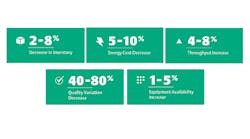Today’s manufacturers face the growing challenge of staying nimble in an ever-changing global marketplace. Companies must accelerate speed to market, and quickly pivot their operations to capitalize on new opportunities, but in many cases, with smaller, less skilled workforces.
Automation systems and process control technologies have been and will continue to be critical enablers to help companies adapt. The organizations that win the future of manufacturing will leverage their automation software and systems to increase speed to market, drive business efficiency and respond to broader social calls to improve sustainability—all foundational elements that meet at the intersection of performance and reputation.
Flexibility, scalability boost speed to market
Gas processors and refiners, pharmaceutical manufacturers, chemical producers and energy companies must often quickly shift production to process higher volumes or different products. Digital automation technologies enable the flexibility to easily bring new manufacturing online or shift production to accelerate speed to market.
Newer digital automation technologies are software-oriented and built from the ground up to support flexible production. As software-defined control takes center stage, production lines will require fewer physical changes to automation hardware and controllers. Making changes to software, as opposed to hardware, will cut the cost and time it takes to adjust production.
Added support for new approaches, such as module type package (MTP) integration, will support modular manufacturing, enabling “ballroom-style” production lines where key equipment can be swapped out quickly to seamlessly change products and manufacturing designs.
In tandem with adding MTP support, automation vendors are increasingly offering more integrated automation systems. Natively integrated systems accelerate capital projects and operational changes, making it easier and less time consuming to commission and integrate devices, controllers and control systems—and to leverage the data produced by these systems for operational benefits.
Process control systems also enable operations efficiency in other areas. Tight integration between a control system and real-time scheduling software makes it easier to implement adaptive production scheduling based on real-time plant activity in industries from life sciences to gas processing.
Cloud tech supports business efficiency
Cloud computing is enabling organizations to improve business efficiency with increasingly optimized and profitable operations.
Today’s organizations often need fast infrastructure changes to support immediate business initiatives and needs. For example, in life sciences, manufacturers must perform complex computing on a massive scale during R&D as they work toward their final production plans. When the final product formulation is achieved and mass production moves forward, much of the modeling equipment needed up front is no longer necessary as the focus shifts from changing recipes to producing consistent quality.
To rapidly cycle business strategies and deliver new products safely and quickly to market, many of these organizations are moving process modeling and simulation to cloud-hosted environments. Cloud technologies enable manufacturers to rapidly adjust the computing power they need without ever having to worry about changing footprint. Increasing computing power for R&D is as simple as scaling up their cloud agreement, allowing teams to always work on the newest and best technologies, without the cost and complexity of adding new IT hardware.
Cloud-based simulation models can then be seamlessly ported to provide ways for operators to train and test new strategies offline, providing a path to performance improvement and personnel upskilling, all without risk to operations or personal safety.
Hosting critical modeling and simulation data in the cloud also provides easy access to analytics tools, and increases accessibility and visibility of data across the enterprise for improved technology transfer and collaboration. Global users and enterprise-level systems can quickly and easily access plant data to monitor, trend and improve efficiency, enabling better business decisions across a fleet.
A similar trend is found in capital projects across nearly every industry. Forward-thinking organizations are using cloud technologies to take essential stages off the critical path. Modern capital projects rely on experts worldwide to improve project outcomes. However, the cost and complexity of traveling among staging sites in multiple world areas can quickly erode efficiency.
Fast, secure cloud deployment of engineering and collaboration tools helps teams leverage expertise from around the globe without the need for travel, helping project teams bring new initiatives and product lines online faster. Cloud engineering and virtual factory acceptance testing (FAT) enables teams, clients and suppliers to collaborate independent of location, using a virtual testing environment from wherever they're located. Thorough process and equipment configuration, commissioning and FAT can all be completed without waiting for equipment to arrive. Using these digital tools, teams can reduce late-stage changes and shipments to multiple locations that delay projects and increase costs.
Enabling sustainability
Pressure has steadily increased from consumers and institutional investors for manufacturers to reduce energy and materials use, and limit production emissions. There are many ways to approach more sustainable operations, but organizations having the most success are focused on one key concept: performance and sustainability are two sides of the same coin.
Properly improving performance includes eliminating waste—wasted time, materials, product and emissions. Digital control technologies are key enablers of more sustainable production, helping organizations more easily optimize processes to balance production, energy use and emissions.
Organizations are using digital twin simulation to increase sustainability for capital projects and process improvements. Performing engineering steps in a digital twin environment is the closest a project team can get to zero-impact engineering. The team can make all its mistakes and design changes, and learn lessons in a virtual world with no risk of environmental incidents or exceeding regulatory limits.
Plants are taking advantage of the process optimization benefits of state-based control (SBC) technology to optimize system reliability and performance. SBC uses operator-initiated state transitions coupled with automated control logic to drive processes more accurately to a desired state. Using SBC, process units coordinate automated responses through communication with each other, making it easier to ensure a process is always operating at its best. When individual process elements work together, the result is more efficient production and less waste.
At a more elementary level, many organizations are seeing dramatic improvements in performance and sustainability simply by improving core control loop operation. Emerson has found that in a typical process plant, almost two-thirds of control loops are underperforming. Often, these units are the highest energy consumers in the plant, such as distillation columns
Loop issues are typically due to simple problems such as decreased valve performance, incorrect loop tuning and inappropriate control strategy. High-performing organizations are adding automated monitoring to ensure these root causes do not go undetected.
Planning for success
As the automation system remains a central enabler of operational efficiency, organizations must ensure that their automation doesn't become more inefficient, expensive and complex to manage across the lifecycle. A trusted partner can help accelerate operations and increase ROI as business needs evolve to encompass more complex strategies, such as mobile workflows, remote operations and eventually autonomous operations. Designing automation systems that are integrated, easier to engineer, and easier to manage will also make them more efficient over the lifecycle and drive sustainability across all levels of manufacturing.




